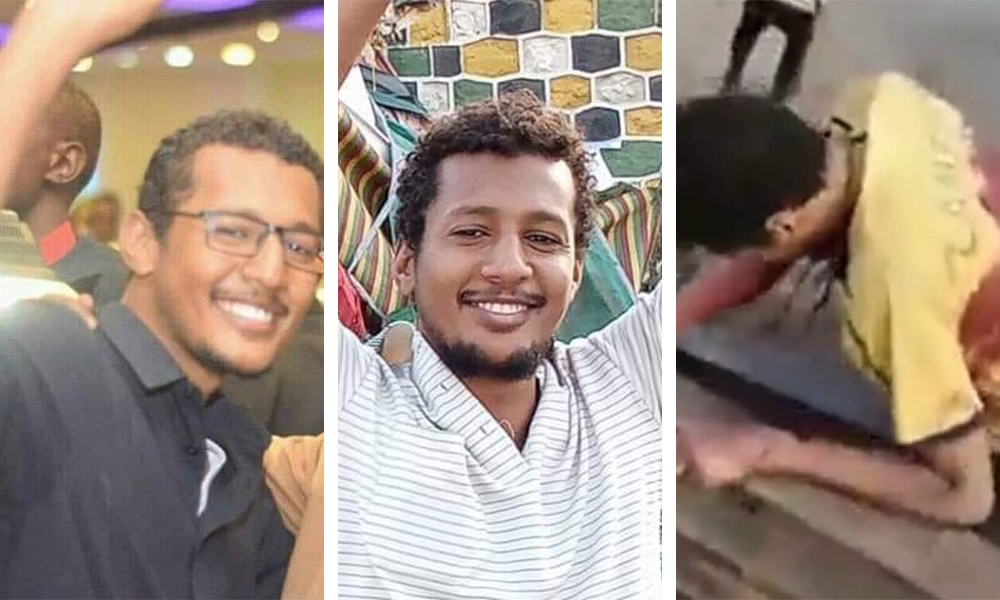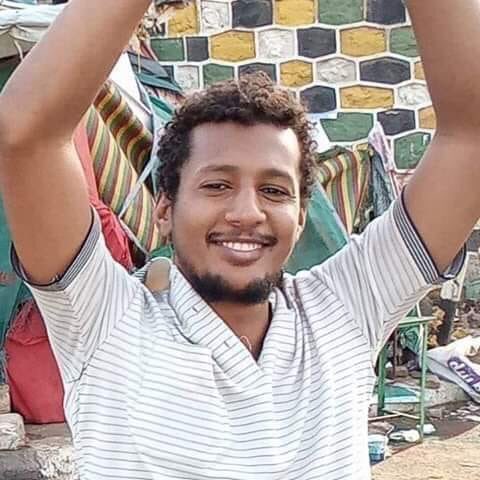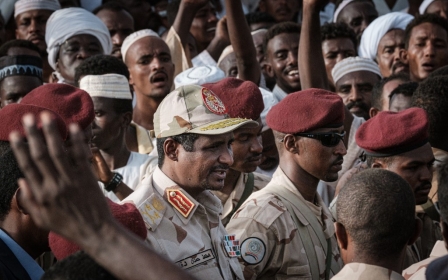'The martyr at the barricades': The life and death of one Sudanese protester

With blood seeping through his yellow shirt, Abbas Farah stumbled with heavy, halting steps towards a barricade. Then he collapsed.
In the first hours of the deadly attack by Sudan’s forces on a peaceful sit-in last month, the image of Farah, somehow still standing after being shot in the stomach, was one of the first and most powerful to emerge of the resistance Sudanese protesters were putting up against the heavily armed military council ruling over them.
Farah later died from his injuries, becoming one of more than 100 people killed on Monday 3 June. Through videos and images that have trickled onto social media in the month since, despite an internet blackout, and by interviewing those who knew him, it is now possible to tell the story of Farah's final hours - and how the sit-in he was defending was bloodily dispersed.
'A revolution of ideas'
New MEE newsletter: Jerusalem Dispatch
Sign up to get the latest insights and analysis on Israel-Palestine, alongside Turkey Unpacked and other MEE newsletters
A 28-year-old engineering graduate, it did not take long for Farah to buy into the uprising that started with economic protests in December 2018. It quickly morphed into opposition to the 30-year rule o0f Sudanese President Omar al-Bashir's, the only leader of the country Farah had ever known.
He spoke to friends and posted philosophically on Facebook about the movement, describing it as a “revolution of ideas” that had to work “for all Sudanese,” including those marginalised under Bashir’s rule.
He was also out on the streets himself, long before protesters escalated their campaign with a sit-in on 6 April that took only days to bring down Bashir.
A former neighbour of his told Middle East Eye that one day in March they were filming from their rooftop while protesters were being chased by Sudan’s notorious National Intelligence and Security Service (NISS) when they saw Farah running from the security officers.
They described Farah as someone who was always happy and welcoming to others around him.
"I moved to the neighbourhood we shared in 2007," the former neighbour said. "He was the first person from the block to ask me to join them for a football match and introduced me to everyone and always made sure I was comfortable as a new kid in the block."
When the sit-in started, Farah became a devoted attendee, first protesting against Bashir and then against the military council that replaced him.
“The blood of the martyrs and the establishment of rights is more important than the treasures of the earth,” he wrote on Facebook.
The dispersal
For almost two months, the sit-in at the heart of Khartoum had become almost celebratory. Though it had come under attack from military forces and militias on several occasions, its jubilant atmosphere encouraged families to happily join the protest with their children.
But the sit-in was abruptly and violently dispersed early on the morning of 3 June when Sudanese forces stormed the camp, firing live ammunition, burning tents and raping women, according to activists' accounts.
The attack was widely blamed on the Rapid Support Forces (RSF) militia force controlled by Mohamed Hamdan Dagolo, the deputy head of the transitional military council known as Hemeti.
Footage of the crackdown showed men in RSF uniforms and vehicles taking part, as well as some wearing the uniforms of other branches of the Sudanese security forces.
On social media, a live stream captured the forces firing on protesters. At one point it turned to Farah, stumbling painfully in the opposite direction of the other demonstrators, who were running to confront the militia fighters attacking them.
The person filming grabbed Farah's wrist as he slumped down onto the barricade and called for others to come and take the injured youth. As they carried him away, the sound of bullets crackled in the background.
“I was seriously shocked when I saw the video of Abbas’s death and I felt such strong grief,” childhood friend Raheeg Omar, who lives outside Sudan, told MEE. She said she saw the video several hours after the attack.
“It truly was a massacre on unarmed citizens. They weren’t carrying weapons. They were demanding their most basic rights.”
The video was filmed in Nile Street, where the military claimed it had only cleared an area outside the sit-in. But videos that have emerged appear to show a build-up of forces and attacks on protesters inside the site.
Ths Sudanese Doctors’ Committee, a protester-aligned network of doctors, said at least 100 were killed at the sit-in but the number could be higher because many could not be evacuated after the crackdown. Many bodies were thrown into the Nile.
The hospital
At least 500 injured people were treated at Khartoum’s overloaded hospitals as a result of the attack, according to the doctors. Most suffered bullet wounds. Some had bones broken after being beaten with brute force and others had been stabbed.
A video that emerged weeks later showed Farah being hauled out of a car arriving at Royal Care hospital, near the sit-in, almost completely limp. He is then laid onto a piece of wire railing ripped from the ground as a makeshift stretcher and carried into the hospital.
A photo from inside the hospital shows the same wire railing on the hospital’s floor. Farah is still lying on it with his bloodied yellow shirt lifted up above his chest and a drip connected to his arm as three doctors try to save him.
In the meantime, the hospital itself was besieged by RSF forces, who allegedly attacked doctors and stopped the entry of paramedics and supplies.
A doctor, trying to reach hospitals to volunteer, told MEE on the day that RSF fighters were stopping and threatening to arrest doctors who tried to help.
According to friends, Abbas Farah died after bullets hit his lungs and kidney. Doctors were unable to save him.
A video from inside the hospital shows Farah's mother standing over his body, repeatedly crying his name and pressing her head onto his chest.
March of the Martyrs
In the hours after the camp was destroyed, the RSF spread throughout Khartoum, forcing protesters into their homes, dismantling barricades and pulling passers-by from their cars, creating a widespread sense of fear throughout Khartoum for several days.
But within two weeks the protests were growing again, with people taking to the streets all over Sudan despite the threat of violence. The neighbourhood resistance committee, groups set up by protesters to organise their local activity, started a march towards Farah's home to pass their condolences to his family.
"The blood of the martyr is my blood, the mother of the martyr is my mother," they chanted.
Translation: the mother of the martyr Abbas Farah with the procession of the Arkweet resistance committees today
On 30 June, protest leaders called for a “march of millions” that brought out massive crowds around the country despite blocks on them marching to key government and military sites to protest. Their gathering points were the homes of killed protesters.
"Words cannot explain the amount of pain I have inside," said Farah's old neighbour.
"All that is keeping me going is that the fight isn’t over and I have to convert all of this negativity into positivity until we all celebrate our victory soon and retaliate with peace and justice for all our martyrs."
Middle East Eye delivers independent and unrivalled coverage and analysis of the Middle East, North Africa and beyond. To learn more about republishing this content and the associated fees, please fill out this form. More about MEE can be found here.





